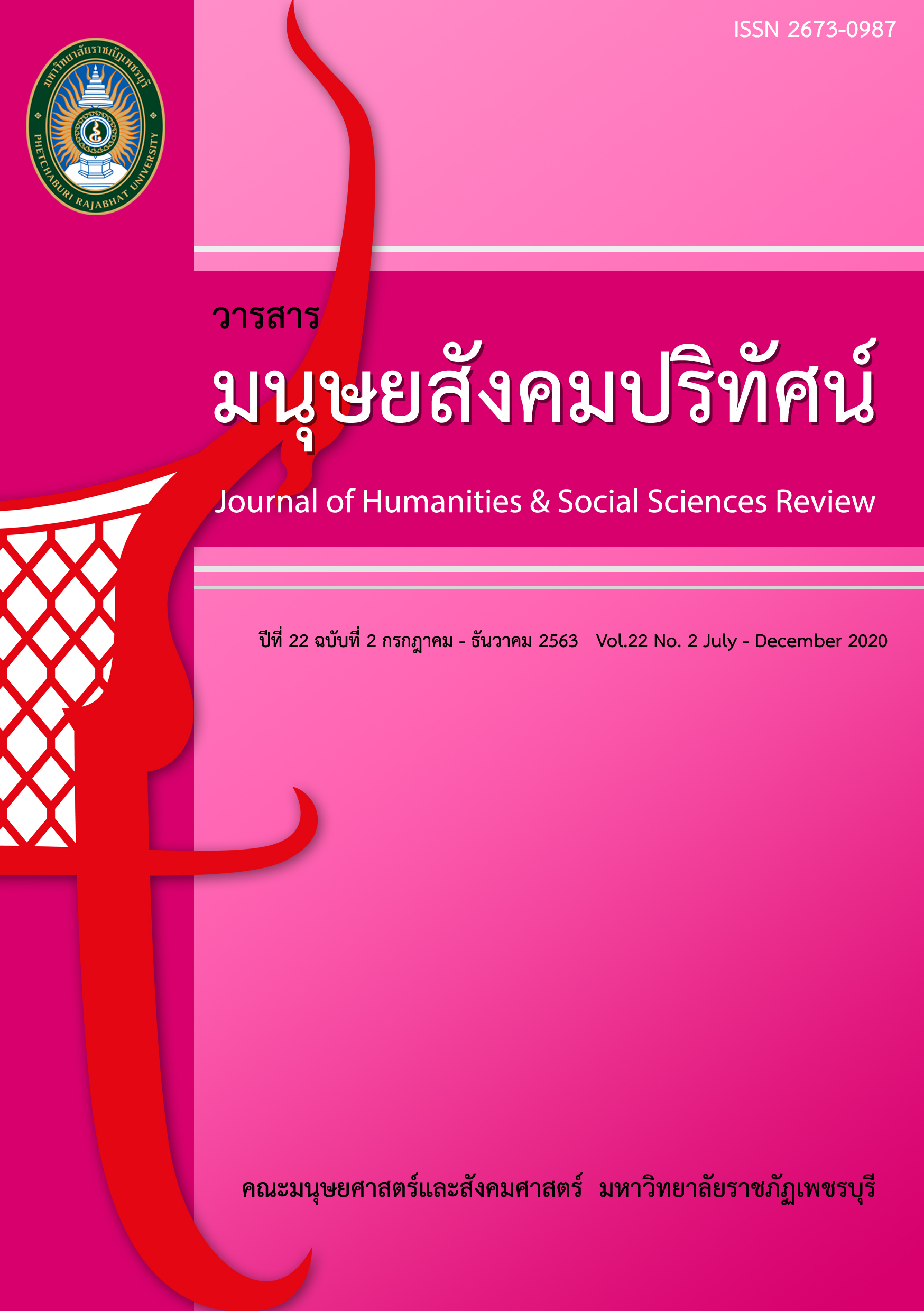การพัฒนาประติมากรรมร่วมสมัย โดยบูรณาการร่วมระหว่างศิลปะจัดวางดิจิทัลอาร์ต และเทคโนโลยีพลังงานแสงอาทิตย์ เพื่อสร้างอัตลักษณ์ภูมิทัศน์ของชุมชน
Main Article Content
บทคัดย่อ
การศึกษาครั้งนี้เป็นการวิจัยเชิงคุณภาพ และการวิจัยเชิงปฏิบัติการแบบมีส่วนร่วมของชุมชน ที่ประกอบไปด้วย การทบทวนวรรณกรรม การตรวจสอบเอกสารและงานวิจัยที่เกี่ยวข้อง และการวิจัยภาคสนาม ที่ใช้วิธีการสัมภาษณ์เชิงลึก และการสนทนากลุ่ม ร่วมกับการผลิตงานสร้างสรรค์ งานประติมากรรมสื่อผสมและการวิเคราะห์อภิปรายองค์ความรู้ที่ได้โดยมีการนำเสนอในรูปแบบการพรรณนา วัตถุประสงค์ของงานวิจัย ได้แก่ 1) เพื่อศึกษาและรวบรวมองค์ความรู้ด้านศิลปกรรมท้องถิ่นของจังหวัดเชียงราย 2) เพื่อออกแบบและพัฒนาผลงานประติมากรรมร่วมสมัยให้เป็นจุดสังเกต หรืออัตลักษณ์ภูมิทัศน์ของชุมชน บนพื้นฐานของทุนทางวัฒนธรรม ศิลปกรรมท้องถิ่น และแนวคิดเศรษฐกิจสร้างสรรค์ 3) เพื่อกระตุ้นให้เกิดการตระหนักรู้ถึงคุณค่าของภูมิปัญญาท้องถิ่นที่เกี่ยวข้องเชื่อมโยงกับศิลปะล้านนาหรือเชียงแสน ผ่านกระบวนการนำเสนอผลงานประติมากรรมร่วมสมัย และการสร้างองค์ความรู้ใหม่ที่เกี่ยวข้องกับการประยุกต์ใช้ทุนทางวัฒนธรรมแบบเศรษฐกิจสร้างสรรค์ที่เพื่อการออกแบบกระบวนการพัฒนาและการบริหารจัดการท้องถิ่นในด้านการท่องเที่ยวแบบยั่งยืนต่อไป
ผลการวิจัยพบว่า นอกเหนือจากผลผลิตที่ได้ในเชิงประจักษ์ ทั้งประติมากรรมและอัตลักษณ์ภูมิทัศน์ของท้องถิ่น และผลลัพธ์ที่อาจจะสร้างนวัตกรรมสนับสนุนและส่งเสริมการท่องเที่ยว ยกระดับคุณภาพชีวิตของท้องถิ่นได้แล้ว ชุมชนยังอาจได้รับองค์ความรู้ผ่านกระบวนการวิจัย ที่ประกอบไปด้วยหลักทฤษฎีที่เกี่ยวข้องดังนี้ 1) รูปแบบการเรียนรู้ผ่านกระบวนการทางศิลปะ เป็นกระบวนการที่ผสมผสานกันระหว่างกระบวนการที่ก่อให้เกิดความรู้ และกระบวนการที่ก่อให้เกิดความซาบซึ้งหรือการเห็นคุณค่า หรือเป็นศาสตร์ที่เรียกว่าสุนทรียศาสตร์ 2) รูปแบบกระบวนการเรียนรู้ ที่มีการใช้กระบวนการคิด และกระบวนการทางสังคม หรือกระบวนการกลุ่ม ค้นหาความรู้ หาผลผลิต 3) การวิจัยเชิงปฏิบัติการอ้างอิงชุมชน เป็นการวิจัยที่เกิดจากพลังแห่งการร่วมมือของชุมชนและสถาบันการศึกษาที่ก่อให้เกิดการระดมทรัพยากรในท้องถิ่นจากทุกแหล่งมาสร้างสรรค์ก่อให้เกิดประโยชน์แก่ชุมชนอย่างมีประสิทธิภาพสูงสุด
Article Details
1. มุมมองและความคิดเห็นใด ๆ ในบทความเป็นมุมมองของผู้เขียน คณะบรรณาธิการไม่จำเป็นต้องเห็นด้วยกับมุมมองเหล่านั้นและไม่ถือเป็นความรับผิดชอบของคณะบรรณาธิการ ในกรณีที่มีการฟ้องร้องเกี่ยวกับการละเมิดลิขสิทธิ์ ให้ถือเป็นความรับผิดชอบของผู้เขียน แต่เพียงผู้เดียว
2. ลิขสิทธิ์บทความที่เป็นของคณะมนุษยศาสตร์และสังคมศาสตร์ มหาวิทยาลัยราชภัฏเพชรบุรีมีลิขสิทธิ์ถูกต้องตามกฎหมาย การเผยแพร่จะต้องได้รับอนุญาตโดยตรงจากผู้เขียนและมหาวิทยาลัยราชภัฏเพชรบุรีเป็นลายลักษณ์อักษร
เอกสารอ้างอิง
2. การไฟฟ้าฝ่ายผลิตแห่งประเทศไทย. (2554). เทคโนโลยีเซลล์แสงอาทิตย์. สืบค้นเมื่อ 8 พฤษภาคม 2562, จาก http://www4.egat.co.th/re/solarcell/solarcell.htm.
3. เกษม ก้อนทอง. (2549). ศิลปะสื่อประสม. กรุงเทพฯ: ศิลปาบรรณาคาร.
4. กำจร สุนพงษศรี. (2555). สุนทรียศาสตร์ (พิมพ์ครั้งที่ 2). กรุงเทพฯ: สำนักพิมพ์แห่งจุฬาลงกรณ์มหาวิทยาลัย.
5. จุฑาพรรธ์ (จามจุรี) ผดุงชีวิต. (2551). วัฒนธรรม การสื่อสารและอัตลักษณ์. กรุงเทพฯ: สำนักพิมพ์แห่งจุฬาลงกรณ์มหาวิทยาลัย.
6. ชุติมา เวทการ. (2551). การจัดการการเรียนรู้สาระทัศนศิลป์บนพื้นฐานวัฒนธรรมชุมชน. กรุงเทพฯ: วี.พริ้นท์ (1991).
7. เทศบาลตำบลท่าสาย. (2559). สภาพทั่วไปและข้อมูลพื้นฐานของเทศบาลตำบลท่าสาย. สืบค้นเมื่อ 18 ตุลาคม 2562, จาก http://tumboltasai.go.th/aboutus.php.
8. บันเทิง พาพิจิตร. (2549). ประเพณี วัฒนธรรมไทยและคติความเชื่อ. กรุงเทพฯ: โอเดียนสโตร์.
9. ภาสกร คำภูแสน. (2552). แนวทางการจัดการภูมิทัศน์วัฒนธรรม: กรณีศึกษาชุมชนริมน้ำจันทบูร จังหวัดจันทบุรี. การศึกษาอิสระ ภูมิสถาปัตยกรรมศาสตร์มหาบัณฑิต คณะสถาปัตยกรรมศาสตร์ มหาวิทยาลัยศิลปากร.
10. ราชบัณฑิตยสถาน. (2524). พจนานุกรมศัพท์สังคมวิทยา (อังกฤษ-ไทย) ฉบับราชบัณฑิตยสถาน. กรุงเทพฯ: รุ่งศิลป์การพิมพ์ (๑๙๗๗).
11. รังสรรค์ โฉมยา. (2548). เอกสารประกอบการสอนวิชาจิตวิทยา. ภาควิชาจิตวิทยาการศึกษาและการแนะแนว คณะศึกษาศาสตร์ มหาวิทยาลัยมหาสารคาม.
12. วิบูลย์ ลี้สุวรรณ. (2548). ศิลปะในประเทศไทย. กรุงเทพฯ: ศูนย์หนังสือลาดพร้าว.
13. วิรุณ ตั้งเจริญ. (2552). มศว 60 ปี ศรีสง่ามหานคร : มหาวิทยาลัยศรีนครินทรวิโรฒ 28 เมษายน 2552. กรุงเทพฯ: มหาวิทยาลัยศรีนครินทรวิโรฒ.
14. สิริอร วิชชาวุธ และคณะ (2550). จิตวิทยาทั่วไป (พิมพ์ครั้งที่ 5). กรุงเทพฯ: มหาวิทยาลัยธรรมศาสตร์.
15. สุรพล ดำริห์กุล. (2561). ประวัติศาสตร์และศิลปะล้านนา. นนทบุรี: เมืองโบราณ.
16. สุวิมล ว่องวานิช. (2552). การวิจัยปฏิบัติการในชั้นเรียน (พิมพ์ครั้งที่ 12). กรุงเทพฯ: โรงพิมพ์แห่งจุฬาลงกรณ์มหาวิทยาลัย.
17. อานันท์ กาญจนพันธ์. (2555). เจ้าที่และผีปู่ย่า พลวัตของความรู้ชาวบ้าน อำนาจและตัวตนของคนท้องถิ่น. เชียงใหม่: ภาควิชาสังคมวิทยาและมานุษยวิทยา คณะสังคมศาสตร์ มหาวิทยาลัยเชียงใหม่
18. อิทธิพล ตั้งโฉลก. (2550). แนวทางการสอนและสร้างสรรค์จิตรกรรมขั้นสูง. กรุงเทพฯ: อมรินทร์ พริ้นติ้ง.
19. Cambridge University. (2020). Landmark. Retrieved May 7, 2018, from https://dictionary.cambridge.org/dictionary/english/landmark.
20. Harris, M. (1993). Culture, people, nature: An introduction to general anthropology (6thed.). New York: Harper Collins College Publishers.
21. Julio. (2019). Geometrías de la Luz: la exhibición que tomará Jardines de México. Retrieved April 28, 2019, from https://travelandleisure.mx/america/2019/07/26/geometrias-de-la-luz-la-exhibicion-que-tomara-jardines-de-mexico/.


